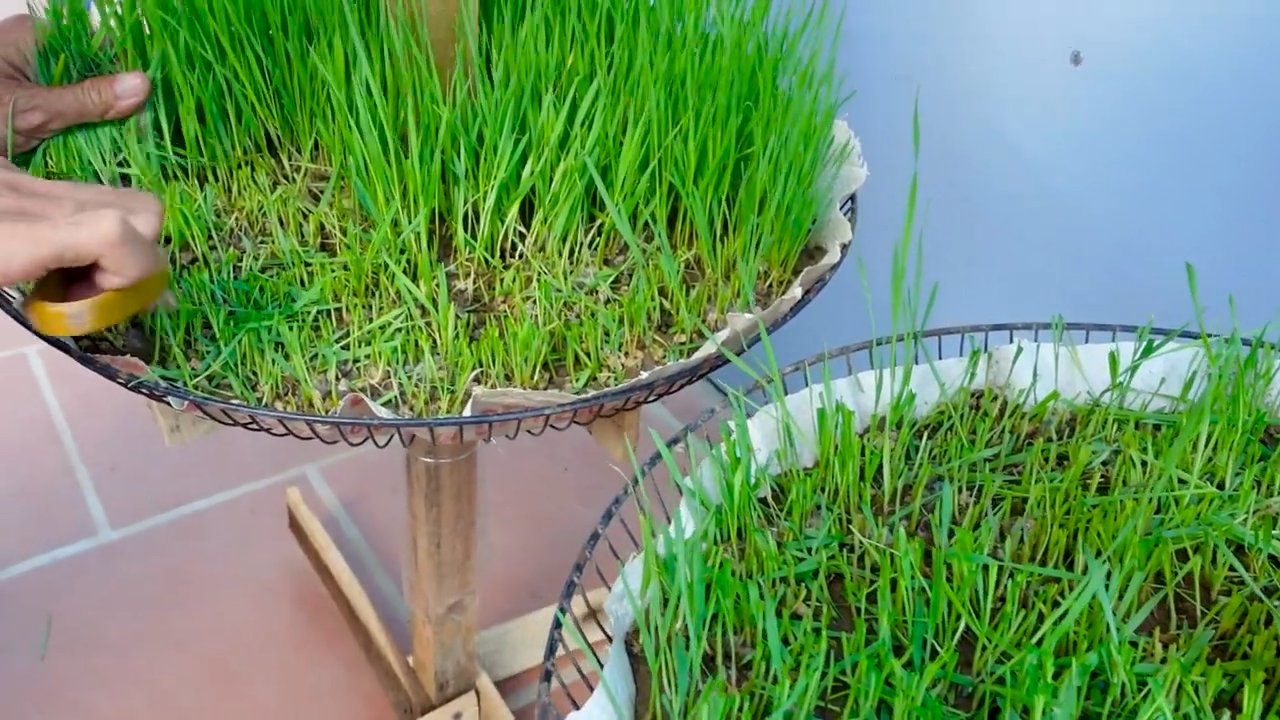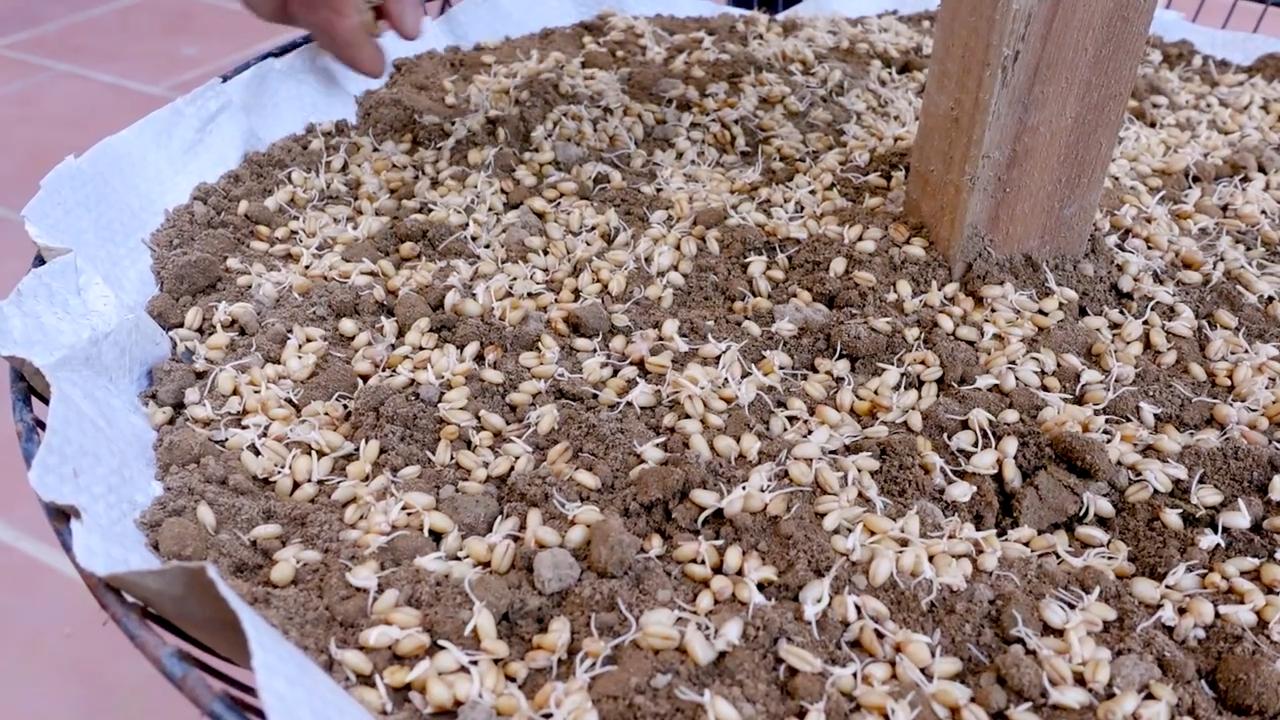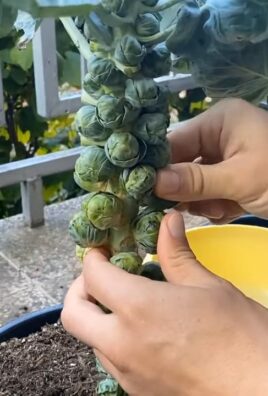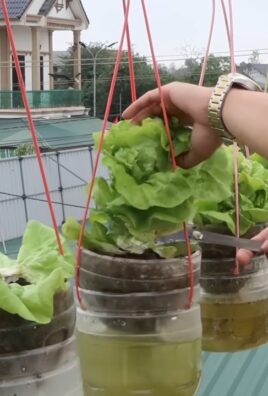Homemade Wheatgrass Juice: Ever dreamt of sipping on a vibrant green elixir, bursting with energy and health benefits, all from the comfort of your own home? I know I have! For centuries, cultures around the world have revered the power of plants for healing and vitality, and wheatgrass is no exception. From ancient Egyptians who prized its rejuvenating properties to modern-day health enthusiasts, the allure of this potent grass remains strong.
But let’s be honest, buying pre-made wheatgrass juice can be expensive and sometimes lacks that fresh, vibrant flavor. That’s where the magic of DIY comes in! This article is your ultimate guide to creating your very own homemade wheatgrass juice, packed with nutrients and bursting with flavor. I’ll walk you through everything you need to know, from sourcing the best wheatgrass seeds to mastering the juicing process.
Why is this DIY trick a game-changer? Because it empowers you to take control of your health and well-being. You’ll save money, enjoy a fresher, more potent juice, and experience the satisfaction of growing your own superfood. So, grab your gardening gloves, and let’s embark on this exciting journey to unlock the power of homemade wheatgrass juice!

Making Your Own Vibrant Wheatgrass Juice at Home
Okay, so you’re ready to dive into the world of homemade wheatgrass juice? Awesome! It’s a fantastic way to boost your health with a concentrated dose of vitamins, minerals, and antioxidants. Plus, it’s surprisingly easy to do once you get the hang of it. I’m going to walk you through everything you need to know, from growing your own wheatgrass to juicing it for that vibrant green shot.
What You’ll Need
Before we get started, let’s gather our supplies. Here’s a list of everything you’ll need to successfully grow and juice your own wheatgrass:
* Wheatgrass Seeds: Look for hard red winter wheat seeds specifically for sprouting. You can find these at health food stores, garden centers, or online. Make sure they are organic and untreated.
* Growing Trays: You’ll need at least two shallow trays with drainage holes. One tray will hold the soil, and the other will act as a drip tray.
* Potting Soil: Use a good quality organic potting soil or seed starting mix. Avoid soils with added fertilizers, as we want the wheatgrass to grow naturally.
* Spray Bottle: For misting the wheatgrass seeds and sprouts.
* Wheatgrass Juicer: This is the most important piece of equipment! A manual or electric wheatgrass juicer is specifically designed to extract juice from the tough wheatgrass blades. Masticating juicers work best. Centrifugal juicers are not recommended as they don’t extract juice efficiently from wheatgrass.
* Water: Filtered water is best for soaking the seeds and watering the wheatgrass.
* Optional: A small fan to improve air circulation and prevent mold growth.
Growing Your Wheatgrass: A Step-by-Step Guide
This is where the magic happens! Growing your own wheatgrass is a rewarding experience, and it ensures you’re getting the freshest, most nutrient-rich juice possible.
1. Soaking the Seeds:
* Rinse your wheatgrass seeds thoroughly under cool water to remove any debris.
* Place the rinsed seeds in a large jar or bowl and cover them with plenty of filtered water. The seeds will expand as they soak, so make sure there’s enough room.
* Let the seeds soak for 8-12 hours, or overnight. This process helps to soften the seed coat and kickstart germination.
* After soaking, drain the water and rinse the seeds again.
2. Sprouting the Seeds:
* Spread the soaked seeds evenly in a sprouting tray or a shallow container. You can use a sprouting lid or cover the container with cheesecloth to keep the seeds moist.
* Rinse the seeds with fresh water 2-3 times a day, making sure to drain the water completely after each rinse. This prevents mold growth and keeps the seeds hydrated.
* After a day or two, you’ll start to see tiny white sprouts emerging from the seeds. This is a sign that they’re ready to be planted.
3. Planting the Seeds:
* Fill your growing tray with about 1-2 inches of potting soil. Moisten the soil thoroughly with water, but don’t make it soggy.
* Spread the sprouted seeds evenly over the surface of the soil. Don’t overcrowd them, as this can lead to mold growth.
* Gently press the seeds into the soil.
* Cover the seeds with a thin layer of soil or vermiculite. This helps to keep them moist and protected.
* Water the seeds gently with a spray bottle.
4. Caring for Your Wheatgrass:
* Place the growing tray in a well-lit area, but avoid direct sunlight, which can scorch the delicate sprouts. A bright windowsill or a grow light works well.
* Water the wheatgrass regularly, keeping the soil moist but not waterlogged. Use a spray bottle to mist the sprouts, or gently pour water into the tray.
* Ensure good air circulation around the wheatgrass to prevent mold growth. A small fan can help with this.
* After a few days, the wheatgrass will start to grow rapidly.
5. Harvesting Your Wheatgrass:
* Your wheatgrass is ready to harvest when it’s about 4-7 inches tall and has developed a vibrant green color.
* Use clean scissors or a sharp knife to cut the wheatgrass just above the soil line.
* Harvest only what you need for juicing, and leave the rest to continue growing. You can usually get 2-3 harvests from each tray of wheatgrass.
Juicing Your Wheatgrass: The Extraction Process
Now for the fun part – turning those beautiful green blades into a potent shot of goodness!
1. Preparing the Wheatgrass:
* Rinse the harvested wheatgrass thoroughly under cool water to remove any dirt or debris.
* Cut the wheatgrass into smaller pieces, about 1-2 inches long. This makes it easier to feed into the juicer.
2. Using Your Wheatgrass Juicer:
* Follow the manufacturer’s instructions for your specific wheatgrass juicer.
* Feed the wheatgrass slowly and steadily into the juicer. Avoid overloading the juicer, as this can cause it to clog.
* If you’re using a manual juicer, you’ll need to apply some pressure to extract the juice.
* If you’re using an electric juicer, it will do most of the work for you.
3. Collecting the Juice:
* Place a glass or container under the juicer’s spout to collect the juice.
* The juice will be a vibrant green color and have a slightly sweet, grassy taste.
4. Enjoying Your Wheatgrass Juice:
* Drink your wheatgrass juice immediately after juicing for the best flavor and nutritional value.
* Start with a small amount, such as 1-2 ounces, and gradually increase the amount as you get used to it.
* You can drink wheatgrass juice straight, or mix it with other juices, such as apple juice or carrot juice, to improve the taste.
Tips for Success
Here are a few extra tips to help you grow and juice the best wheatgrass possible:
* Use high-quality seeds: This is crucial for getting a good yield and healthy wheatgrass.
* Don’t overwater: Overwatering can lead to mold growth, which can ruin your crop.
* Provide good air circulation: This helps to prevent mold growth and keeps the wheatgrass healthy.
* Harvest at the right time: Harvesting too early or too late can affect the flavor and nutritional value of the juice.
* Clean your juicer thoroughly: This prevents the buildup of bacteria and ensures that your juice is clean and safe to drink.
* Experiment with different growing methods: There are many different ways to grow wheatgrass, so experiment to find what works best for you. Some people prefer to grow it in soil, while others prefer to grow it hydroponically.
* Store your wheatgrass properly: If you’re not going to juice your wheatgrass immediately, you can store it in the refrigerator for a few days. Wrap it in a damp paper towel and place it in a plastic bag.
Troubleshooting Common Problems
Even with the best intentions, you might encounter a few challenges along the way. Here’s how to troubleshoot some common problems:
* Mold Growth: This is a common problem, especially in humid environments. To prevent mold growth, ensure good air circulation, avoid overwatering, and use clean growing trays. If you see mold, remove the affected areas immediately.
* Slow Growth: If your wheatgrass is growing slowly, it may not be getting enough light or water. Make sure it’s in a well-lit area and that the soil is consistently moist.
* Yellowing Leaves: This can be a sign of nutrient deficiency or overwatering. Make sure you’re using a good quality potting soil and that you’re not overwatering the wheatgrass.
* Poor Juice Yield: If you’re not getting much juice from your wheatgrass, it may not be mature enough, or your juicer may not be working properly. Make sure you’re harvesting the wheatgrass at the right time and that your juicer is clean and in good working order.
Cleaning Your Wheatgrass Juicer
This is a super important step! A clean juicer is a happy juicer (and a healthy you!).
1. Disassemble the Juicer: Carefully take apart all the removable parts of your wheatgrass juicer. This usually includes the auger, screen, and any other components that come into contact with the wheatgrass.
2. Rinse with Water: Immediately after juicing, rinse all the parts under running water to remove any remaining wheatgrass pulp

Conclusion
So, there you have it! Ditching the expensive juice bar runs and embracing the vibrant, verdant world of homemade wheatgrass juice is not just a trend; it’s a commitment to your well-being. We’ve explored the simplicity of growing your own wheatgrass, the ease of juicing it at home, and the incredible benefits that come with each potent shot.
Why is this DIY trick a must-try? Because it puts you in complete control. You know exactly what’s going into your juice – no hidden additives, no questionable ingredients, just pure, unadulterated wheatgrass goodness. You’re saving money, reducing your environmental impact by avoiding single-use plastic containers, and connecting with nature in a tangible, rewarding way. Plus, let’s be honest, there’s a certain satisfaction that comes from nurturing something from seed to superfood.
But the adventure doesn’t stop here! Feel free to experiment with variations to find your perfect wheatgrass juice blend. Try adding a slice of lemon or lime to cut through the earthy flavor. A small piece of ginger can add a warming spice and boost the anti-inflammatory properties. For a sweeter twist, consider juicing a green apple or a few slices of pineapple along with your wheatgrass. Remember to start small with additions, as wheatgrass has a strong flavor that can easily be overpowered.
Beyond flavor enhancements, consider the timing of your wheatgrass juice consumption. Many find that drinking it first thing in the morning on an empty stomach maximizes its absorption and energizing effects. Others prefer to take it as a pre-workout boost or as a mid-afternoon pick-me-up. Experiment and discover what works best for your body and your lifestyle.
The key to successful homemade wheatgrass juice is consistency. Make it a regular part of your routine, even if it’s just a small shot a few times a week. The cumulative benefits of this powerful superfood are truly remarkable.
We wholeheartedly encourage you to embark on this DIY journey and experience the transformative power of homemade wheatgrass juice for yourself. Don’t be intimidated by the process; it’s much simpler than you might think. And most importantly, don’t be afraid to experiment and find what works best for you.
Once you’ve tried it, we’d love to hear about your experience! Share your tips, tricks, and favorite variations in the comments below. Let’s build a community of wheatgrass enthusiasts and inspire others to embrace this healthy and rewarding practice. Your insights could be invaluable to someone just starting out. So go ahead, give it a try, and let us know what you think! Unlock the power of homemade wheatgrass juice today!
Frequently Asked Questions (FAQ)
What kind of juicer do I need for wheatgrass?
The best type of juicer for wheatgrass is a masticating juicer, also known as a slow juicer or cold-press juicer. These juicers extract juice by crushing and pressing the wheatgrass, rather than using high-speed blades that can generate heat and destroy some of the nutrients. Masticating juicers yield more juice and preserve more of the enzymes and vitamins in the wheatgrass. While centrifugal juicers can technically juice wheatgrass, they are not as efficient and may not extract as much juice. If you’re serious about making wheatgrass juice regularly, investing in a masticating juicer is highly recommended. However, if you only plan to juice wheatgrass occasionally, you might consider using a high-powered blender with some water to help it blend, then strain the mixture through a nut milk bag or cheesecloth. This method isn’t as efficient as using a juicer, but it can work in a pinch.
How much wheatgrass juice should I drink per day?
It’s best to start with a small amount of wheatgrass juice, such as 1-2 ounces (30-60 ml), and gradually increase the amount as your body adjusts. Wheatgrass is a potent detoxifier, and drinking too much too soon can cause nausea, headaches, or other unpleasant side effects. Most people find that 2-4 ounces (60-120 ml) per day is a good amount to reap the benefits without experiencing any negative reactions. Listen to your body and adjust the amount accordingly. Some people can tolerate more, while others may need to stick to a smaller dose. It’s also a good idea to drink wheatgrass juice on an empty stomach for better absorption.
How do I store wheatgrass juice?
Wheatgrass juice is best consumed immediately after juicing to maximize its nutritional value. However, if you need to store it, do so in an airtight container in the refrigerator. The juice will start to degrade quickly, so it’s best to drink it within 24 hours. After that, the enzymes and vitamins will start to diminish. To minimize oxidation, fill the container to the top to reduce air exposure. You can also add a squeeze of lemon juice to help preserve the juice. Freezing wheatgrass juice is also an option. Pour the juice into ice cube trays and freeze. Once frozen, transfer the cubes to a freezer bag. You can then thaw a cube or two as needed. Frozen wheatgrass juice can last for several months, but the quality may slightly decrease over time.
How do I grow my own wheatgrass?
Growing your own wheatgrass is surprisingly easy and rewarding. You’ll need wheatgrass seeds (available at most health food stores or online), a tray with drainage holes, potting soil, and water. Soak the seeds in water for 8-12 hours. Then, spread the soaked seeds evenly over a layer of potting soil in the tray. Cover the seeds with a thin layer of soil and water gently. Keep the soil moist but not waterlogged. Cover the tray with a lid or plastic wrap to create a humid environment. Place the tray in a warm, dark place for the first 2-3 days, until the seeds sprout. Once the seeds have sprouted, remove the lid and move the tray to a sunny location. Water the wheatgrass regularly, keeping the soil moist. The wheatgrass will be ready to harvest in about 7-10 days, when it’s about 4-6 inches tall. Cut the wheatgrass just above the soil line with scissors. You can usually get two or three harvests from each batch of seeds.
What are the benefits of drinking wheatgrass juice?
Wheatgrass juice is packed with nutrients and offers a wide range of potential health benefits. It’s a rich source of vitamins, minerals, enzymes, and antioxidants. Some of the reported benefits include:
* Boosting the immune system
* Detoxifying the body
* Increasing energy levels
* Improving digestion
* Reducing inflammation
* Alkalizing the body
* Supporting healthy skin and hair
While more research is needed to confirm all of these benefits, many people swear by the positive effects of wheatgrass juice.
What does wheatgrass juice taste like and how can I make it taste better?
Wheatgrass juice has a strong, earthy, and slightly bitter taste that some people find unpleasant. However, there are several ways to make it more palatable. As mentioned earlier, you can add a slice of lemon or lime, a small piece of ginger, or a green apple or pineapple to the juice. You can also mix it with other juices, such as carrot juice or orange juice. Another trick is to drink the juice quickly, followed by a chaser of something sweet or refreshing. Some people find that holding their nose while drinking the juice helps to minimize the taste. Ultimately, it’s a matter of personal preference, so experiment with different methods until you find what works best for you. Remember, the health benefits are worth the initial taste adjustment!




Leave a Comment